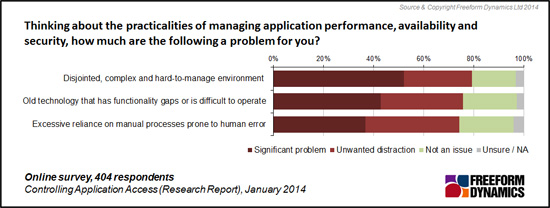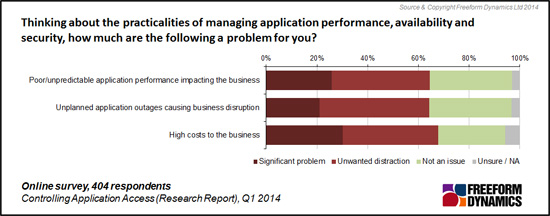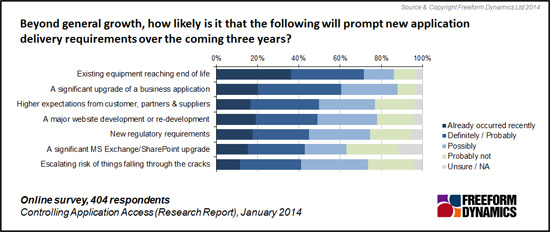By Tony Lock
Networks are the glue that allow users to function effectively in their daily tasks, yet a recent report by Freeform Dynamics shows many of you are using old equipment that is hard to manage. This begs the question, “does senior management really care about the state of enterprise networks, or are they happy to take it for granted until something breaks”? (Figure 1)
Figure 1
It is evident that a majority of the networks you operate are fragmented and difficult to manage. The odds are that many of the essentials of your networks may have been put in place over the course of the last five, ten, or perhaps fifteen years. There is even a chance that it was never really architected as a whole but has been built in a disorganized fashion to cater for individual application requirements case by case.
When we asked what problems managing the performance, availability and security of the applications on which your organisations depend, your replies were very clear. (Figure 2)
Figure 2
The majority of readers who took part in the survey confirm there are challenges with respect to application performance and availability. The problems are not only about slow response times or systems being unavailable, but include the question of performance consistency. Fifteen years ago most users were annoyed, if unsurprised, when network connectivity was lost or service quality deteriorated.
Today users complain if performance isn’t consistently perfect, regardless of where they are working, how they are connected or the devices and networks they are using. Perhaps more importantly, over half of the respondents taking part indicated that unplanned outages are causing business disruption.
This takes us on the question of how good are your management capabilities, and do you see any areas where you should be looking to beef things up? (Figure 3)
Figure 3
The answers you gave in the survey show that you have obvious capability shortfalls evident in nearly every area of network performance and availability. The fact that a majority of readers highlight all areas as targets for improvement confirms you see a real need for them. But what might actually trigger changes to your application delivery networks and how you administer them? (Figure 4)
Figure 4
As can be seen in Figure 4, new ways of handling application delivery requirements can be initiated by a range of events. With nearly four out every five respondents acknowledging running old technology with functionality gaps (Figure 2), it is no surprise you see existing equipment reaching end of life to be the most likely initiator of change.
Other triggers for over half of you include major business application upgrades, web site development and increased security demands. Even modifications to regulatory requirements and Exchange / SharePoint upgrades are mentioned by two out of five readers.
The danger is that any modifications to the enterprise application access infrastructure resulting from the investment prompts noted above could simply lead to piecemeal implementation of new networking solutions without changing the way networks are managed as a whole. Such an approach perpetuates the fragmentation you already acknowledge to exist in your networks. It is also likely to further exacerbate any operational management difficulties you have.
A new approach is needed, one where the performance, availability and security aspects of application access for every service are assessed individually. A network then needs to be built able to handle the new demands being placed upon it, one with better management characteristics that demand less of time to keep operational and secure.
The first challenge is to convince your budget holders it’s time to invest in redesigning the corporate application access and security networks. The second, equally daunting, challenge involves how do you upgrade your network architecture and management processes without negatively impacting service levels? This is the IT equivalent of changing the tyres on a racing car while it is tearing around the circuit in the middle of a Formula One Grand Prix.

Tony is an IT operations guru. As an ex-IT manager with an insatiable thirst for knowledge, his extensive vendor briefing agenda makes him one of the most well informed analysts in the industry, particularly on the diversity of solutions and approaches available to tackle key operational requirements. If you are a vendor talking about a new offering, be very careful about describing it to Tony as ‘unique’, because if it isn’t, he’ll probably know.







Have You Read This?
Generative AI Checkpoint
From Barcode Scanning to Smart Data Capture
Beyond the Barcode: Smart Data Capture
The Evolving Role of Converged Infrastructure in Modern IT
Evaluating the Potential of Hyper-Converged Storage
Kubernetes as an enterprise multi-cloud enabler
A CX perspective on the Contact Centre
Automation of SAP Master Data Management